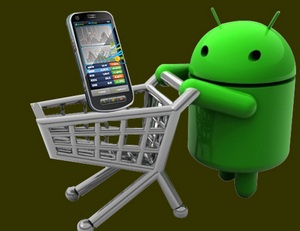 With smartphone users on the rise Nielson says that in 2012 47% of smartphone owners use mobile shopping apps in the Shopping / Commerce category. Although these do not account for actual mobile payment transactions they show that smartphone users are frequently turning to their mobile devices to find deals and purchase information.
With smartphone users on the rise Nielson says that in 2012 47% of smartphone owners use mobile shopping apps in the Shopping / Commerce category. Although these do not account for actual mobile payment transactions they show that smartphone users are frequently turning to their mobile devices to find deals and purchase information.
But what exactly is m-commerce? M-commerce is a hybrid technology that takes web technologies that scale screens to mobile devices like Apple iPads and Android tablets. The commerce end of it comes from shoppers and merchants actually executing payment transactions over mobile devices of some form. So m-commerce and e-commerce tend to work with web or mobile application development that use the tablet or cellular connection. The focus with m-commerce takes place where mobile devices are concerned.
Today many merchants are ditching their old point of sale hardware and opting for a sleek solution found in tablets like the iPad or an Android tablet. Tablets having the in between form factor of a full PC monitor and a smart phone. Thanks to new development paradigms, responsive web development allows an application to be ‘responsive’ to the device rendering it’s elements. By using responsive design on a web site the PC will render one view optimized for large screens while a tablet renders a separate view optimized for that screen size. Smartphones having a much smaller screen are rendered independently from the other two devices giving one web application (like an e-commerce shopping cart site) 3 separate views based on the size of their display.
Point of Sale companies are now moving their development to this new paradigm so they can leverage a Point-Of-Sale experience to tablets and smartphones so that a sales force can view live inventory and sell remotely anywhere in the world. Cash drawers and receipt printers are available for retail outlets that can work from the same point of sale system creating a centralized accounting in real time.
Some interesting aspects of mobile point of sale and m-commerce are the methods of payments. Depending on the capabilities of your merchant account services provider and their gateway, transactions can be quite multifaceted.
The most common mobile payments are:
1. Mobile Payment in a closed environment. This is when a large merchant creates it’s own digital wallet application such as Starbucks did. They ran 3 million mobile payment transactions in their first to months.
2. Mobile Payment Platform. This is a broad coverage term for any payment method a customer uses to send a merchant funding from their smartphone or tablet. Sending money to a merchant via PayPal while interacting with the sales team would be covered under this payment category.
3. Mobile Point of Sale or MPOS. A tablet or a smartphone is used to select items and fill out a sales order. The mobile point of sale application tracks inventory, fills out a sales order and then accepts payment using a credit card swipe reader or the credit card information is keyed in. The transaction is then sent to a mobile payment gateway over the internet either wifi or through the cellular tower to complete the mobile payment process.
4. Direct Carrier Billing. Here a mobile shopper uses their cell phone bill as a mobile payment option. The customer receives the merchandise and waits for their phone bill to arrive. These purchases are itemized on their phone bill and included with their monthly service.
5. Mobile at Point of Sale. After explaining MPOS (mobile point of sale) you might think this one has to do with Point of Sale. This method is actually AT Point-of-Sale meaning the digital wallet type technology. Tap to Pay with Near Field Communications embedded in cell phones will become more ubiquitous and we might soon find ourselves tapping to pay for our goods at the register.
February 25th, 2024 by Admin
 With smartphone users on the rise
With smartphone users on the rise